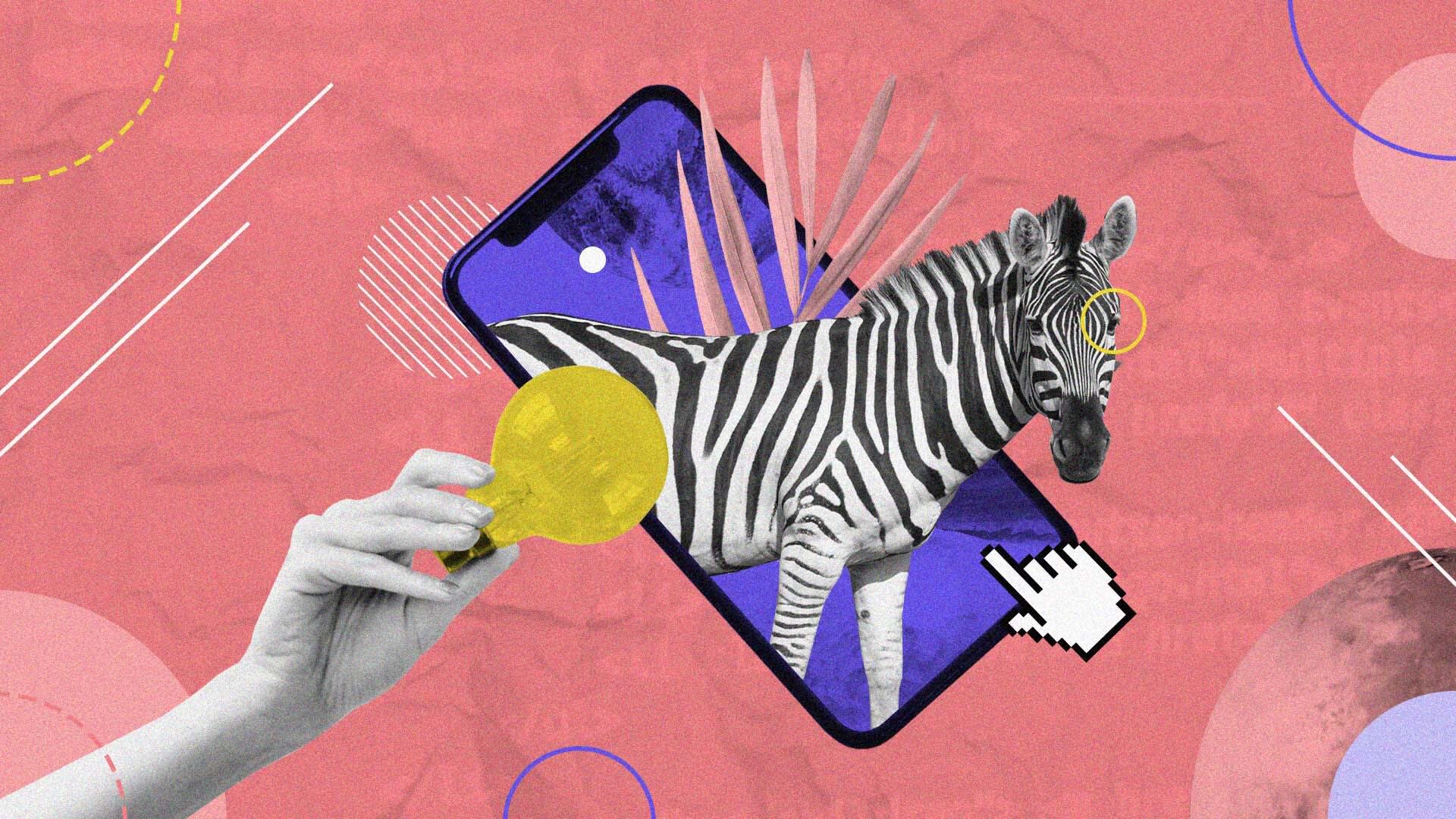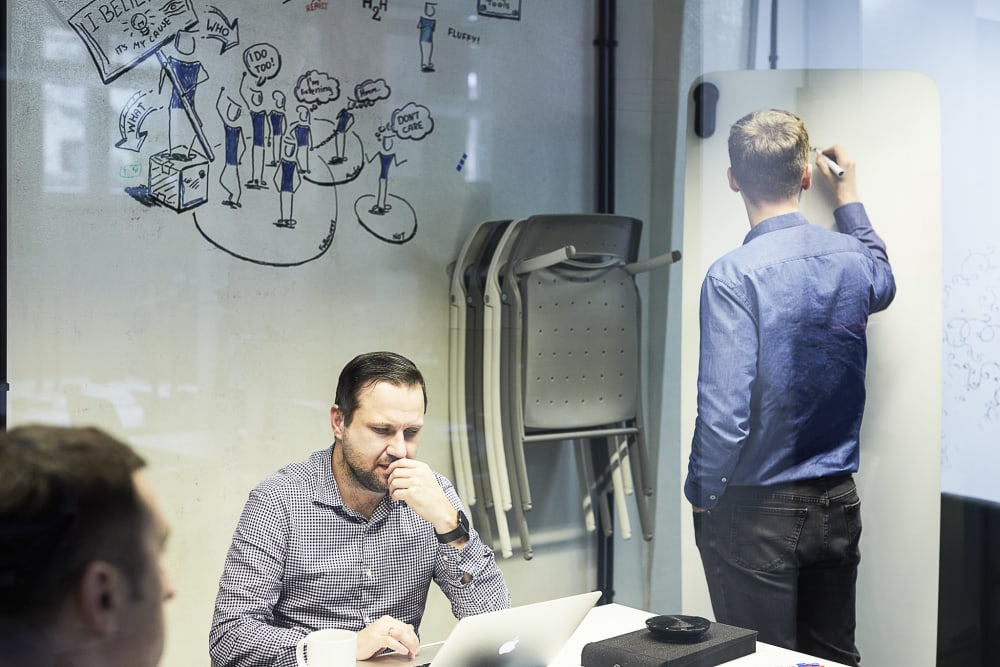Digital product design process – a step by step guide
So, you have an idea. A vision. A concept in your head that addresses the challenges faced by your business and your users. But without a strong product design process in place, that’s often the beginning and the end of the story. The business world is littered with the remnants of great ideas poorly executed, or worse, not actioned at all. Often, because there were no clear steps to follow. How to create a path for developing a successful and meaningful product?

Table of contents
How do we define the product design process?
The product design process is a term used to describe all the steps your team takes while conceptualizing, developing, and bringing the product to the market. At its very core, it revolves around spotting a market opportunity, understanding how you can address it, and developing a real-life solution to users’ problems.
While there isn’t a one-size-fits-all, single approach to the product design process, here are the seven steps we recommend using. As with everything else in Agile, some of these stages can be tweaked or reshaped to better match your project needs.
The 7 product design steps
There are 7 steps to an effective product design process, let’s start with the product vision.
1. Defining the product vision
Your product vision is the starting point of the entire product design process. It’s both a strategic tool and a tactical necessity, giving everyone a clear aim and understanding of their role. Communicating a product vision at the very start of the journey gives every stakeholder a glimpse of what success must look like.

So, you need to begin by defining your vision, clearly and precisely. To start, identify the what, the how, the why, and the who.
What do you want to achieve?
A product vision isn’t ‘an app’ or ‘the best website in the business.’ These are wildly unspecific, open to interpretation – an unattainable dream that not even all of Elon Musk’s billions could make a reality. ‘An app that translates lyrics into foreign languages. ‘A website that helps customers find cheap socks.’ ‘A rocket ship to Mars.’ These are all examples of solid product visions.
How are you going to achieve this?
Think big, but make sure that your goal is within your reach. The most successful product visions are ambitious but not unattainable – rather than going big on your first try, it can be easier to continually build on smaller successes iteratively (and, in doing so, gather good data on what works and what doesn’t). As you determine how you intend to make your vision a reality, consider the time required, resources you have or need, and who needs to work on this project.
Why are you doing this?
Whether you’re entering a new market or filling a gap in an existing one, everyone involved in the project must know why the vision is important. ‘Purpose’ might have become a buzzword over the last year, but don’t underestimate its unifying power. More than any other consideration, the why is entwined with the who – your core audience.
Who is this for?
Your end product needs to be focused on the consumer. If they don’t benefit from it, then it won’t be successful, certainly not in the long run. Even internal reshuffles – switching from on-premises to cloud, for example – should be valuable to your customers, clients, or users, offering a more efficient service or more secure processes. Put your consumers front and center of your vision.
2. Product research
With a product vision in place, it’s time to explore just how viable it is. Product research is a data-gathering exercise. The goal is to see how your product fits in the market and discover what your users think about it (because, eventually, you’re going to use that information to iterate and refine your product).

There are several ways to do this.
Interviews
Interviews are the quickest and most straightforward way to collect data from users. How you perform these is up to you, but the best results will usually come from face-to-face interviews, as they offer more context. When a person says ‘yes’, but their body language says ‘no’, that’s instructive and useful for your company. It’s not always easy to parse when conducting online interviews; even less so if these are performed through text chats.
Surveys
Surveys are a critical part of your research kit. You can deploy them at almost any stage of product development and still gain useful information. They tend to be simple to create using free tools. Also, many users like them because they’re less intensive than interviews – although they won’t spark a conversation in the same way.
The trick to gathering the best data is to ask the right questions. Avoid binary choices. ‘Yes/No’ questions might seem useful, but they won’t give you the full picture. You can’t act on them in the same way you can by using qualitative questions like ‘How did our app make you feel?’ During the preliminary stages, ask open-ended questions as these won’t limit what your users tell you. And keep your questions short, so users can easily understand and answer them.
Field studies
Field study (sometimes called contextual inquiries) is a bit like bird-watching. It’s an opportunity to silently observe users engaging with your product, or at least similar tasks and processes, to help you understand what they do and how they do it. You should be able to capture the frustrations they have when performing X compared to Y, for example. Your final product will seek to resolve or improve these experiences.
3. User and market analysis
Once you’ve completed the product research phase, it’s time to make sense of all that information. You should have plenty of data, and your analysis should seek to draw insights from it. There are two effective ways to visualize your data and make your findings actionable.
Personas
Creating user personas is an effective way to put your data into context. Personas act as generalized avatars of your users that help you understand what they want from your product. It’s a good way to help your team visualize the end user.
While it can be tempting to create idealized personas – i.e., the users you want, not the users you have – it’s a mistake. Personas should be based on real-world data, reflecting real-world users. Be sure to include information relevant to your company, market, and product, like biographical and employment details. Then, go beyond this, recording their personalities and needs.
Empathy maps
Empathy maps facilitate the empathetic design and empower you to create user-centric experiences. A common empathy map uses a quadrant format and asks:
- What do your users say about your product?
- What do your users think about using your product?
- What do your users feel, what excites them, scares them, makes them jump for joy?
- What do your users do when using your and comparable products?
Ground these answers in real-world data.
4. Ideation Stage
It’s time to get creative. During the ideation stage, give designers free rein to conjure up an array of solutions. Anything goes. No idea is a bad idea. Except when it is – because ideation is more than brainstorming brilliant ideas. As you progress through the stages in product design, you’ll have collected and studied a large amount of data. Use this to drive ideation towards the best possible end product. It’s all too easy to focus on that ingenious idea everyone loved, and assume your users will, too.
You can deploy several techniques to help you stay on track.
User journey mapping
A user journey map visualizes the user flow, looking at where they go and what they do on your site and in your app. This helps you build an accurate understanding of how best (and where best) to engage users. It adds the context behind each click of the mouse or tap of the screen.
User stories
Agile-driven businesses will already be familiar with user stories: they offer a way of exploring your end goal – your product vision – from the user’s perspective. These are typically quite short pieces, structured simply to articulate who the user is, what action they want to take, and what they expect from the outcome.
Storyboarding
As the most visual way to present ideas, storyboards are also one of the most accessible – ideal for communicating ideas to those outside your team. Here, you can show the flow of a user’s journey, screen by screen. Base these on the frustrations and challenges faced by users (and how your solution can overcome them). This data should already have been collected during your user research phase.
Sketching
Sketching is a useful way to keep your users in mind. Best deployed during your brainstorming sessions, you can quickly whip up a sketch on paper or using design tools. It’s not a prototype or a wireframe; it’s more basic than that. But it’ll give everyone a good sense of the idea, and how best to work it up into something more tangible or actionable.
5. Design
Equipped with the right data, your design team should now be in a strong position to begin work. They’ll have a clear idea of what they need to create. It may not be exactly what you set out to build – the data should’ve driven you towards what’s likely to be most successful – but your overall product vision should remain the same.
There are multiple stages in this product design process.
Begin with your design specifications.
These specs should cover everything your designers need to begin work. This includes an overview of the project, the target audience, the needs of the user, and the requirements of your team. If you have specific features or aesthetics such as brand colors, put these into the specification, too.
With a strong design specification in place, you can move on to wireframing.
Wireframing, also known as low-fidelity prototyping, is the start of bringing your vision to life.

Wireframes don’t need to work precisely, but they should give you a clear indication of what’s working and what needs re-working. As you continue to refine the ideas, you can gradually raise the fidelity until you have something closer to a finished product.
6. Testing and validation
With a high-fidelity prototype in place, you can begin to see how right (or wrong) your instincts were because of the user testing (source) and validation product design steps are the moments when you make first contact with your users.
It’s an opportunity to see what users think about your product and how they use it.
Usability testing
You can perform usability tests in a variety of ways. This includes introducing hand-picked target audience users into a controlled environment (known as ‘lab testing’), and guerilla testing (source), which lets you test your product with a large, random cross-section of the market. There’s no right or wrong choice, it all comes down to what fits your product and project needs.
You may also want to include remote usability tests, such as phone interviews. These often yield more considered responses; however, they also remove the ability to observe users during the test stages in product design.
Generally, aim to include five users during any standard test – research suggests (source) this will be enough to catch up to 85% of issues.
A good usability test focuses on five aspects:
- Can users easily learn how to use the product?
- Can users use the product quickly and efficiently?
- Will users remember how to use the product when they return to it?
- Are there any bugs and errors that need resolving?
- Does the product offer a satisfying experience?
Session recordings
Session recordings are an integral part of the testing phase. They can be performed remotely or face-to-face and are ideal for projects that haven’t hit the market yet. They provide great insight into how users interact with your project. You’ll be able to study these to iron out any kinks in the user experience.
How you respond to these tests will determine how successful the end product will be. Tempting though it is, don’t champion the aspects users love while ignoring the niggles and complaints users may have. These are the people who will use the product, after all. Or not, if you don’t act on their feedback.
7. Post-launch
Just because your product has launched, doesn’t mean the product design steps come to an end. In one sense, this is just the beginning. Your product vision is now a product reality – so it’s time to see where you can enhance the experience. A core factor in these types of product design processes is continuous improvement.
As such, the post-launch product design process must include:
Understanding user interaction
Now your product is ‘live’, you’ll be able to see whether users are using the end product as intended. Instantly, a keen eye will see how expectations measure up to real-world results (no strategy, after all, survives first contact with the user).
Internally, you should have a clear understanding of what success looks like – you’ll have defined this during the initial phase. Now, you need to agree on how this success will be measured. Identify the key metrics; for example, increased conversions or users.
Collecting user feedback
Analytics aren’t everything. Take time to speak directly with your users. When devising a feedback strategy, consider what you want to find out and how best to reach the right users. Email questionnaires, surveys inside the product, and even quick interviews can all offer invaluable insights to act upon.
Testing new designs
The product design process never stops – and with that in mind, you’ll want to consider introducing variant (or A/B) testing (source). Design variants help you understand the engagement levels of different designs – it might be something simple, like changing the color of your call-to-action button, or a larger change, like switching page layouts. You’ll then have a stronger idea of what appeals to your users, informing the development and design of future iterations.
Stages in product design – final remarks
Building products that will effectively address users’ needs is hard, if not impossible without the right digital product design process in place. Not only will it act as guidance, making sure that all your decisions are well-thought-out and justified, but it will also help to ensure you have the right people on board and that everyone is following the same vision.
If you’re searching for a tech partner that will help you turn your idea into reality, get in touch with us. We’ll happily discuss your options.
Share this article:








